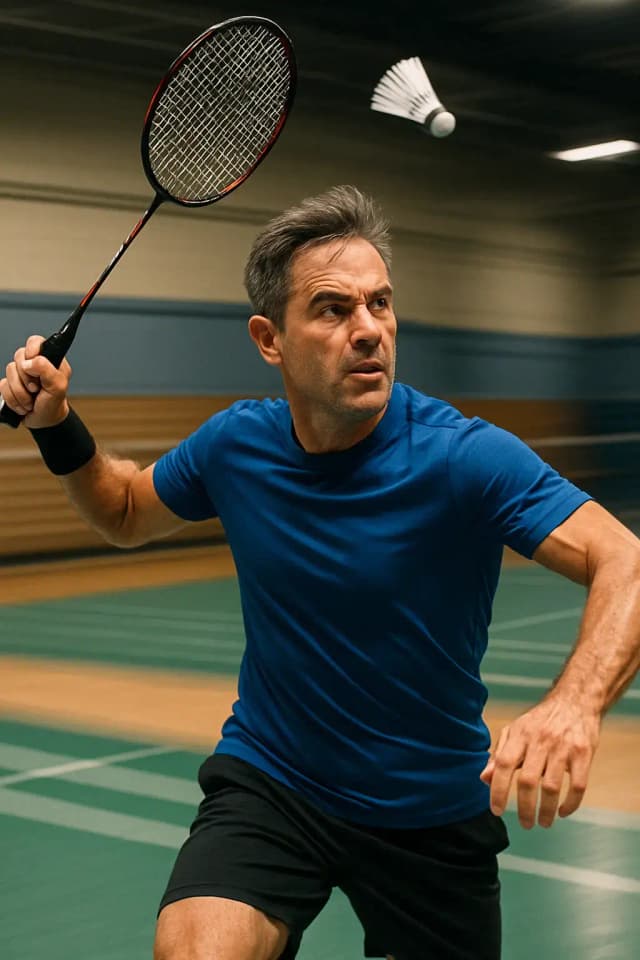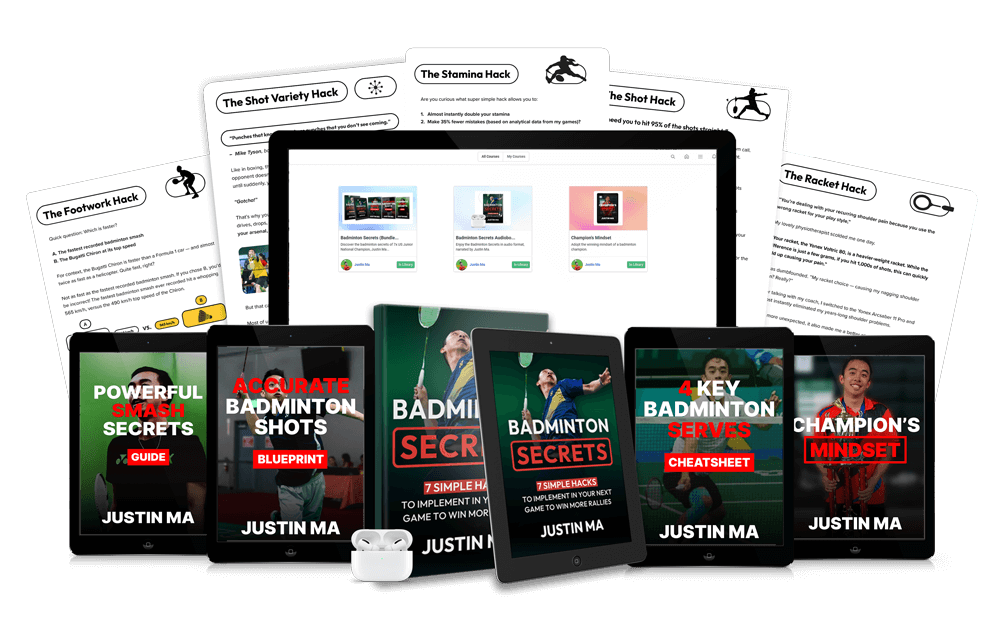By Justin Ma, 7x US Junior National Badminton Champion.
Last updated August 13, 2024
·
6 min read

Have you ever wondered how you can become a professional badminton player?
I’ve started playing badminton 18 years ago, and signed my first professional contract as a badminton player 8 years ago.

In that time:
In this post, you’ll discover the 5-step process I’ve followed to become a badminton player. As a quick overview:
| # | Step | Summary |
|---|---|---|
| 1 | Learn From Other Professional Badminton Players | Learn from experienced players to break through plateaus and improve your game. |
| 2 | Master the Fundamentals Of Playing Badminton | Consistent practice of fundamentals is key to professional success. |
| 3 | Don’t Neglect Your Physical Fitness | Maintain peak physical fitness to handle the demands of badminton. |
| 4 | Play Badminton Often | Practice regularly and frequently to build and reinforce good habits. |
| 5 | Watch Badminton Matches | Observe and analyze both your own matches and professional games to improve your overall game. |
Let’s dive right in:
Whenever you play badminton for a longer time, you’ll ultimately reach a plateau. The same thing happened to me.
I’ve played badminton since 10, and in my early twenties (just after going pro), I felt like I no longer knew how to level up my game.
That’s when a former Olympian and online coach, Raju Rai, contacted me.
At first, I was hesitant: “You’re an online badminton coach? Okaaay.”
But he was persistent.
I gave this a shot. Working with him, I made breakthroughs in my game and started performing the way that I wanted to.
Here’s how my international world rankings climbed when I’ve worked with Raju. I’ve reached my highest world ranking ever:

And, to share it again – because it’s one of the proudest moments of my life: I’ve competed at the 2023 Badminton World Championships:

Professionals never don’t do the basics.
I repeat again: Professionals never don’t do the basics.
If you want to become a professional badminton player, you have to master the basics better than anyone else.
If you want to play badminton professionally, you have to master the boring stuff. Well, let me take that back. You’ll have to love the boring stuff.
This means the footwork, regular shots (smash, drop shot, lift, clear, net), and hand-eye coordination drills that make you look weird—those drills that you’d rather not do.
Because they’re neither cool, nor fun. But… if you want to be a professional badminton player, you have to treat badminton like work.
It’s exactly those drills that you need to practice if you really want to play badminton at national-level tournaments (and international tournaments, for that matter).
The fastest recorded smash in badminton was 493km/h. The shuttlecock is the fastest-recorded object in sports.
It moves, on average, 1.9x faster than a tennis ball.
The game of badminton is the fastest racket sport. This means badminton players have to be capable of moving fast and changing directions frequently.
Not only that, they also need:
… to react to the shots and strike the fast shuttlecock effectively.
You also need to be flexible enough to bend to strange positions – all the while maintaining a stable upper body to hit a controlled shot. You also need endurance as rallies and matches last 3 sets and can go on for hours.

And you need muscular strength, to smash hard and defend hard smashes.
In short: You need everything. Badminton is such a complex physical sport that there’s no way around being at the best physical fitness level that you can be.

If you want to become a world-class badminton player, you have to practice. And you have to practice a LOT.
One time per week is not going to cut it. 3 times per week for 1 hour is the absolute minimum. To achieve my level, I’ve trained 3 hours per day, 5-6 days per week.
We’ve seen in the previous points (especially the first), that training regularly is not everything.
Yes, you can train often and still be a beginner. However, it’s fundamental if you want to become a professional badminton player.
Only if you train often do you build good behavioral patterns that last even when all your chips are on the table, such as in international tournaments.

To learn the strategy in this complex game of badminton, you must watch matches.
Ideally, your own, but professional matches are useful as well. You can learn so much about what you might need to improve from your own matches – what your weak corners are, incorrect footwork or form…
… or when you hit the wrong corner on your opponent’s side.
Similarly, you can learn a lot from watching professionals. These are people who have lived and breathed badminton their entire lives – they pretty much know the right strategy in every single situation.
Try to analyze why they are hitting some shot and replicate that strategy in your own games. As a start, here’s a badminton match of yours truly. Can you see where my strengths and weaknesses are just from watching it?
Let me know in the comments!
Becoming a pro badminton player is not easy. If it were easy, everyone would be doing it. So, being hard is what makes it great.
And, you’ll ultimately need some luck. However, you’ll quickly figure out that the harder you work – the luckier you’ll be.
Cheers,
Justin Ma

I’ve tried to go as in-depth as possible in this article, figuring out exactly which advice I’d give my younger self.
However, I know that there are always unanswered questions, so here they are:
Badminton is an extremely popular sport, which means that there are many people wanting to become professional players.
So ideally, because of the competition, you should start playing badminton at a young age if you want to turn professional. I’ve personally started playing badminton at 10. In an ideal world, I should have started at the age of 3-5.
So, even my starting age was not ideal!
I know professional badminton players that started playing badminton in their late teens, and early 20s – and still turned pro!
So if you start later, you’ll absolutely have to make sure that you have the right coaches and advisors, as you have no time to waste.
While a good coach is important if you start at an early age, it becomes absolutely crucial if you start later.
Good badminton players are masters at the basics. They have great reaction speed, great footwork, and great basic shots (smash, clear, lift, drop shot, net, drive).
Rarely do you ever see a good badminton player do trick shots in a serious match. Professionals are professionals because they understand the value of the basics.
If you want to dominate your opponents on the court, play in national-level tournaments (or even get to the national team) – you need to master the basics.
Don’t worry about the more advanced techniques. It’s literally all about the basics, even when you’re a pro.
If you’re looking to become a badminton player for financial reasons, I’d advise against it.
Over my professional career, I’ve earned $150 total for my participation in BWF tournaments. Most professional badminton players have a full or part-time job on the side.
In comparison to other sports, badminton does not pay well. As BadmintonInsight pointed out:
“Losing in the first round (last 128) of the men’s or women’s singles in Wimbledon gets you $75,926.
If you compare this to losing in the first round of the most prestigious tournament in badminton, the All England, you get $1300.
What’s worse is that this is $1300 for the last 32, not the last 128 which it is in Wimbledon! Losing in the last 32 in Wimbledon gets you $181,001 – 139x more than the badminton equivalent!”
So while badminton players earn something, it’s still 139x less than the tennis equivalent.
